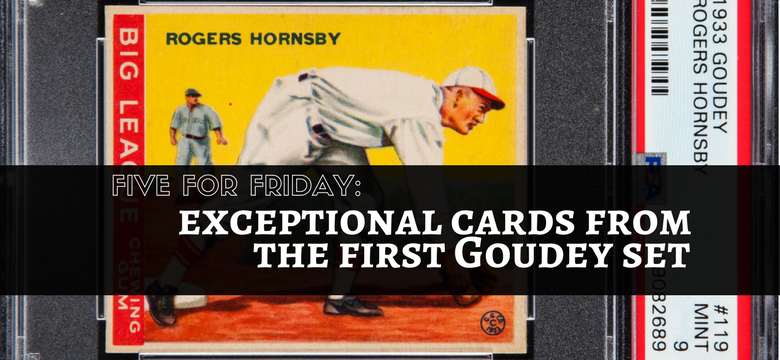Enos Gordon Goudey opened the Goudey Gum Company in 1919 in Boston. Although he sold the company in 1932, Goudey stayed involved as a consultant. Today, the company is known best for its association with collectible baseball cards, which it introduced in 1933. After years of being available with the purchase of cigarettes or certain kinds of candy, Goudey became the first American company to issue cards with gum – a method that came to be known as the standard way to acquire cards.
Many of the unreleased cards, printing plates and company archives were thrown away in the 1960s, although some were sold to collectors.
The cards also are notable in that they feature hand-drawn portraits of players; photographic portraits didn’t become the industry standard until the 1950s. The exceptional artwork on these cards is part of the reason the 1933 set is among the top three most coveted sets in the hobby.
Heritage Auctions will be offering some of the exceptional cards from the first Goudey set in its 1933 Goudey PSA Set Registry Collectibles Catalog Auction Sept. 21 in Dallas, Texas.
1. The set includes cards featuring most of the sport’s greats of the era. Cards depicting Babe Ruth always are among the most coveted collectibles, and this set is no exception. A 1933 Goudey Babe Ruth #53 PSA NM-MT 8 (est. $150,000 and up) is one of four prized Ruth offerings in the auction. This “Yellow Background” card is prized in part because of the way in which it displays Ruth’s joy for the game, but also because it is scarcer than the others in any condition.
2. One card expected to draw heavy interest from collectors is a 1933 Goudey Napoleon Lajoie #106 PSA EX-MT 6 (est. $40,000 and up). The card is coveted by serious collectors more than perhaps any card other than the T206 Honus Wagner; each is so scarce that listed prices for their respective sets are established based on sets without the cards, because they are so rare. What makes this card unique is that it wasn’t even produced until 1934 … and why Lajoie? He had been retired for the better part of two decades. Many of those who purchased Goudey 1933 sets noticed that the Lajoie card was missing, and when collectors – or perhaps an angry mom or dad – wrote to Goudey to ask about it, the company printed it in 1934 along with the final run of cards for that year and sent them to complete people’s sets, which explains the card’s exceptional rarity.
3. If Ruth is revered by many as the greatest player the sport ever produced, the man known as the “Iron Horse” is perhaps the game’s most revered. The 1933 Goudey Lou Gehrig #160 PSA NM-MT+ 8.5 (est. $40,000 and up) portrays the New York Yankees slugger whose streak of consecutive games played was thought to be perhaps the most unbreakable record in baseball (until Baltimore’s Cal Ripken, Jr. surpassed it 56 years later). Gehrig’s remarkable run extended into 1939, but almost ended twice in 1933, the year of this set – once because of a pitch that hit him in the head and again when he got ejected for arguing with an umpire … although his one at-bat before getting tossed gave him credit for playing in the game. Part of the allure of this card is that two Gehrig cards in this set – #160 and # 92 – feature the exact same image – the reasoning behind which never has been explained.
4. The 1933 Goudey set featured few cards in a panoramic (horizontal) format, one of which was the 1933 Goudey Rogers Hornsby #119 PSA Mint 9 (est. $30,000 and up). After Babe Ruth, Hornsby is recognized as perhaps the greatest pure hitter of baseball’s Golden Age, and Hornsby ranks second only to Ty Cobb for the highest career batting average. After more than 80 years, this is one of just three examples of this Hall of Famer’s card that has survived in “Mint 9” condition.
5. Slight design differences can be significant to collectors. Consider the 1933 Goudey Lefty Grove #220 PSA Mint 9 (est. $16,000 and up). The card depicting the Hall of Fame southpaw is one of just a handful at the Mint grade level, with none graded higher. Also significant is the fact that this example – one of the finest examples on record with PSA – was printed later in the year than most, and therefore does not feature the “Big League Chewing Gum” banner across the bottom of the card.
Written by: Steve Lansdale
